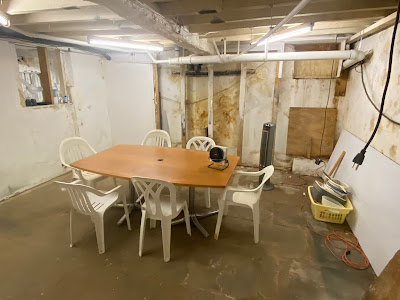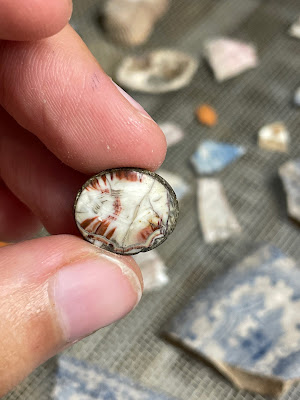Settling into the New Lab! (Taylor Brown)
What started as five empty rooms filled with a few piles of stored supplies has transformed into a public archaeology lab! In the past two and a half weeks, we have made ourselves cozy in the cellar spaces of the Globe Museum in St. George’s. Though we’ve still got some arranging left to do–there is amazing potential to turn this lab into something truly exceptional–it is perfect for our needs this summer.
 |
| The wet lab! |
Once an artifact has been found in the field, it still has quite a ways to go before it arrives in its final destination. For every 1 day spent in the field, archaeologists tend to expect an additional 3 days of work in the lab filled with washing, drying, identifying, inventorying, and preparing for storage.
Take this bone hairbrush.
It was uncovered in the field on June 2nd. It made its way from Smith’s Island, across the harbor, to our lab in St. George’s on June 3rd. Once it had been checked in, it was washed (by hand with a toothbrush!) and set out to dry on a screen. On June 4th, it was identified and inventoried and prepared for long term storage. Eventually, its information will be databased and then incorporated in the overall interpretation of the site. So we’re operating ahead of schedule–only 2 days of lab work instead of 3!
Now imagine all the work that goes into performing all those steps for every single artifact recovered from the field!
This important process wouldn’t be possible without the hard work of our team and our local volunteers, who spend the days washing artifacts until their fingers turn to prunes just so we can keep pace with our field crew!
Ari and E. Michael! Skylar, Kellen, and Ari!
Here are some highlights from what we have found so far.
Two marbles, one clay, one stone, have been recovered. Interestingly, both of them sport a carved “X.” Marbles have been a popular child’s game for centuries–they’ve been found on sites in the Indus Valley, in Roman contexts, and across the colonial Atlantic world. Perhaps these two were owned by the same kid, who proudly marked their prize shooters with an “X”?
It is not unusual to find a plethora of buttons on a historical archaeology site–people were always losing them! Buttons can be made of copper alloy, iron, bone, shell, or even glass. Some of the standout buttons we’ve recovered so far include…
This copper alloy button inlaid with shell.
This British military button, once worn by a soldier in the Royal Regiment of Artillery. The scroll below the three cannon reads “UBIQUE” in Latin, meaning “everywhere.” The motto makes sense considering there are around 90 British military forts on Bermuda alone!
While not a button, these copper alloy cufflinks were also uncovered!
At first, this little piece of tin glaze ceramic looked like every other ceramic sherd. Upon closer inspection, I recognized it as a game piece! Shortly after this ceramic vessel was broken, someone picked up this piece and shaped it into an ovular disc. Examples of these have been found across the Caribbean.
This unusual artifact is likely a broken fragment of a kaolin clay tobacco pipe bowl. Unusual because it has been molded and painted to mimic the face of an animal. Perhaps a lion’s head? What do you see?
And to bring this post full circle, let’s return to that bone hairbrush! Bone hairbrushes were typically made by skilled craftspeople. Once the bone handle and block had been shaped, holes for the bristles were individually drilled by hand. The irregular spacing of the holes on our specimen suggests that it is likely a very early example. Next, boar bristles were selected, cleaned, and arranged in tufts that were bound by copper wire–or silver if the brush was very expensive. The green residue on the back of our hairbrush confirms that ours was likely bound by copper wire. Copper, when it ages, turns green (think Statue of Liberty, or pennies!). Each tuft was then dipped in pitch, which acted as a glue, and placed within the bone block. Once all of them had been installed, the brush was trimmed and ready to be sold! Our brush has lost all its bristles, but imagine what it might have once looked like. Whose hair it might have brushed?
And we just finished the afternoon with a lab day on Paget Island!
Tristan, Josh, Dana, Keegan, Becca, Aleksi, Hannah, Ari & Skylar! Aleksi, Hannah, Dr. Jarvis, Keegan, & Josh! Dana, Kaspar, Tristan, & Becca!
In addition to all of these small finds, the team has uncovered hundreds of historic ceramic, animal bone, shell, iron, glass, and even modern plastic (from the hydroponic farming operation on Smith’s Island in the 1960s).
As always, the lab is alive with discovery! Archaeology is much more than just digging and our project gives everyone involved the unique opportunity to take part in every step of the archaeological process! Stay tuned for our next update!
Lab Manager in her natural habitat.
















.jpg)
Comments